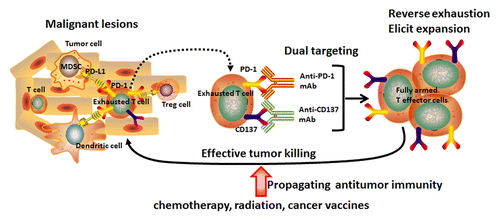Figures & data
Figure 1. Induction of an anticancer immune response by dual targeting of CD137 co-stimulatory and PD-1 co-inhibitory molecules in combination with conventional cancer therapy. Immunosuppressive cells, including myeloid-derived suppressor cells (MDSCs), regulatory T cells (Tregs) and tolerogenic dendritic cells (DCs) are present in the tumor microenvironment. Immunosuppressive cells and their associated cell-cell signaling molecules induce functional exhaustion of tumor-recognizing T cells via programmed cell death-1 (PD-1/PD-L1) and other inhibitory pathways. Dual targeting of CD137/PD-1 abolishes the local suppression and leads to functional rescue and expansion of effector T cells that subsequently kill the cancer cells. Combination with radiotherapy, certain chemotherapeutic drugs or cancer vaccines may also expand the population of tumor-reactive T cells relieved from suppression and cause tumor regression.

